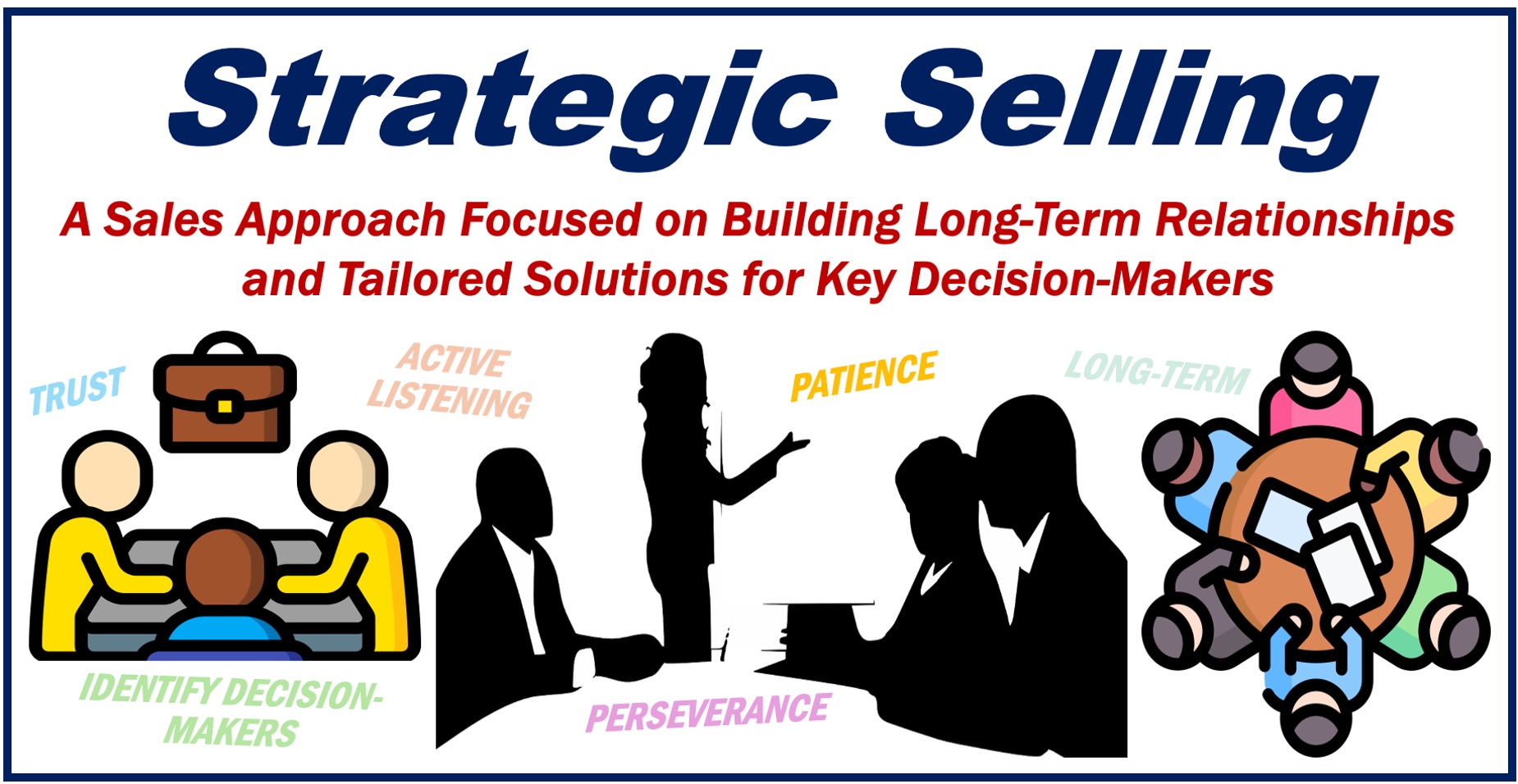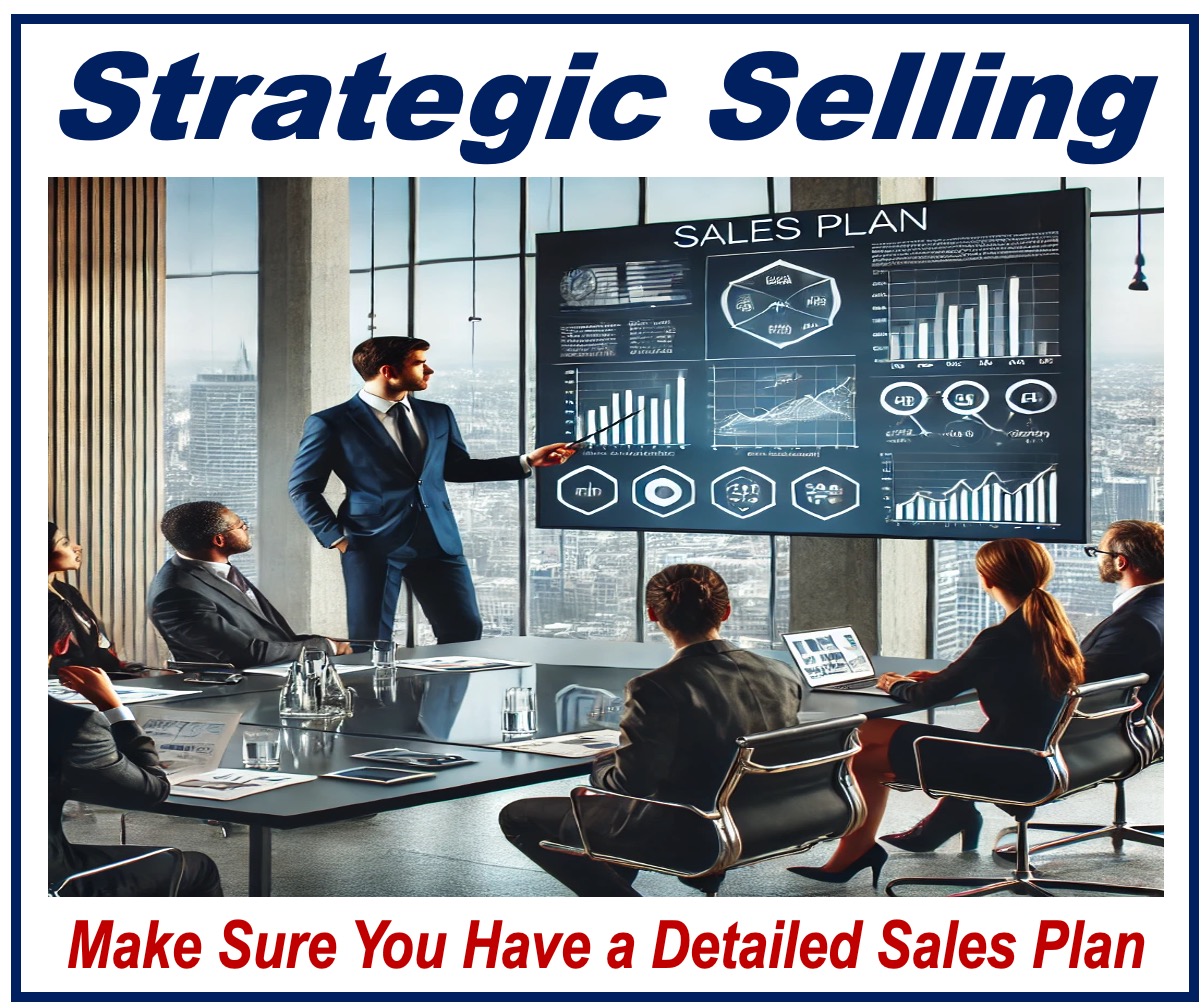If your business focuses on complex and high-value deals, you practice Strategic Selling. You are a Strategic Seller.
Unlike traditional selling methods, which typically aim for quick wins, strategic selling is all about building long-term relationships and understanding the broader context of your client’s business.
Your behavior towards your client or prospect is similar to that of a partner. A prospect is a person or a company that you think could turn into a client.
Strategic Selling vs. Enterprise Selling
Strategic and enterprise selling have some similarities, but they are not exactly the same.
While both focus on building long-term relationships with various stakeholders and decision-makers, and high-value deals, enterprise sellers target only large organizations, while strategic sellers target organizations of all sizes.
Weflow GmbH has the following definition of the term:
“Strategic selling focuses on building relationships with various stakeholders and decision-makers rather than just one contact.”
“Using Strategic Selling techniques, sales teams identify sales opportunities by identifying all key members of the decision-making process, evaluating where they currently stand in regard to purchasing, and then using those insights to tailor their pitch or sales approach.”

Key Elements of Successful Strategic Selling
-
Identifying decision-makers
The core of strategic selling lies in identifying and targeting key decision-makers within a company.
Sometimes, purchasing decisions are not made just by one person, but by a group of stakeholders, especially in large companies and organizations.
As a strategic seller, you must navigate this corporate landscape and understand the needs, motivations and *pain points of each decision-maker. This involves thorough research and a tailored approach for each contact.
* Pain points are specific problems or challenges that clients need resolved.
-
Detailed Sales Plan

A key element of strategic selling is the creation of a detailed sales plan. This plan outlines the steps that you and your team members must take to win a deal.
The plan must take into account potential challenges and strategies to overcome them.
It must be a dynamic plan – one that evolves as you gather new information and circumstances change.
-
Trust
Building trust is crucial in strategic selling. You earn trust through consistent, reliable communication and by demonstrating a deep understanding of your client’s or prospect’s business needs.
You will need to be or become an expert on your client’s market and operations so that you can offer insights into market trends, share relevant case studies, and provide solutions to specific problems they might be facing.
-
Patience and Perseverance
From first contact to signing a deal, can be a very, very lengthy process. As a strategic seller, you must have a long-term perspective. Most deals take months to close; some may even take years.
You must focus on creating value over time rather than immediate gains. This approach helps create a stronger client relationship and often leads to repeat business and referrals.
-
Technology
Customer Relationship Management (CRM) systems help you and your team members track interactions and manage contacts.
With CRM, you gather and analyze data to gain a better understanding of your client’s needs and behaviors.
Tools like email marketing platforms, sales automation software, customer analytics tools, marketing automation systems, contact management software, lead generation tools, data enrichment services, and social media can also support strategic selling efforts by keeping clients engaged and informed.
-
Active Listening
If you are an effective strategic seller, you will be skilled in active listening. Ask open-ended questions to uncover your client’s or prospects true needs and priorities.
If you know what they need and what matters to them the most, you will be able to present solutions that are closely aligned with their goals.
It’s about matching your product or service to their specific requirements, rather than pushing a one-size-fits-all solution.
-
Collaboration
You must work closely with other departments within your company, such as marketing, product development, and customer service, to ensure a cohesive approach.
This internal collaboration ensures that the client receives a seamless and integrated experience.
Other Selling Methods
Strategic selling is one of many different selling approaches. Here are ten other methods, their definitions, and examples of their application in sentences:
-
Inbound Selling or Inbound Marketing
This approach focuses on attracting customers through valuable content and building relationships before directly pushing a sale.
Example: “Inbound selling utilizes informative blog posts and social media engagement to attract leads already interested in the product category.”
Here, the focus is on highlighting the value proposition of your offering, showcasing the tangible benefits the customer will receive.
Example: “Value selling emphasizes demonstrating the return on investment (ROI) the customer will experience with your product.”
Consultative selling emphasizes understanding the customer’s or prospect’s needs and providing tailored solutions.
Example: “Consultative selling allows salespeople to address a prospect’s specific issues with personalized solutions.”
-
Relationship Selling
Building trust and rapport with the customer is crucial in this method, with a focus on developing long-term partnerships.
Example: “Relationship selling focuses on building trust with the customer, creating a collaborative atmosphere rather than just a one-time sale.”
-
Needs-Based Selling
This method emphasizes identifying the customer’s underlying needs and desires, then tailoring your pitch to address them directly.
Example: “Needs-based selling begins with uncovering the customer’s true needs, not just what they initially say they want.”
This technique involves encouraging the customer to purchase a higher-end version of the product they’re considering.
Example: “Upselling might include suggesting a premium service plan alongside the initial product purchase.”
This method recommends complementary products or services that enhance the customer’s initial purchase.
Example: “Cross-selling could involve suggesting a printer cartridge refill program when a customer buys a new printer.”
Enterprise selling targets large organizations, dealing with complex, high-value sales involving multiple decision-makers.
Example: “Enterprise selling requires understanding the intricate structure of large organizations to navigate complex sales processes effectively.”
This method prioritizes completing the immediate sale, focusing on product features and benefits rather than long-term relationships.
Example: “Transactional selling is often used for low-cost, everyday items where the focus is on a quick exchange of goods for money.”
This approach focuses on positioning your product or service as the solution to the customer’s specific problems.
Example: “Solution selling involves identifying a client’s pain points and demonstrating how your product provides the best fix.”
Strategic Selling – Final Thoughts
In summary, strategic selling is about more than just making a sale. It’s about understanding your client’s or prospect’s business, building long-term relationships, and delivering value over time.
By focusing on the bigger picture and aligning your efforts with your client’s goals, you can achieve sustainable success and secure your company’s growth.
Video – What is Strategic Selling?
This video comes from our sister YouTube channel – Marketing Business Network. It explains what “Strategic Selling” is using easy-to-understand language and examples.
